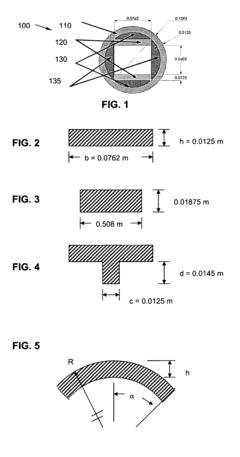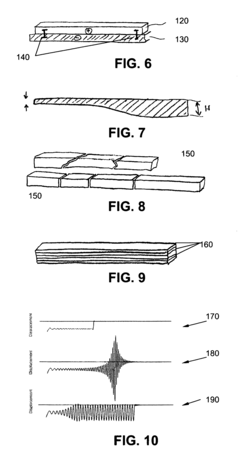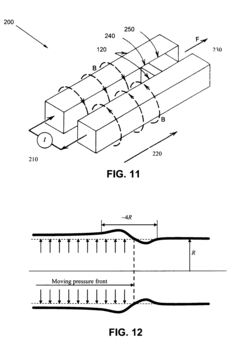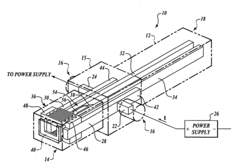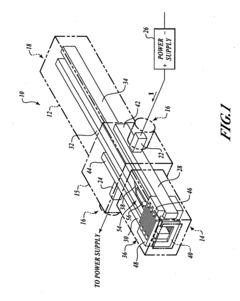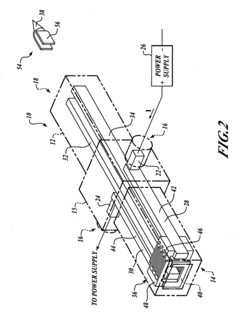Impact of Rail Gun Innovations on Conventional Explosive Weaponry
AUG 6, 20259 MIN READ
Generate Your Research Report Instantly with AI Agent
Patsnap Eureka helps you evaluate technical feasibility & market potential.
Rail Gun Tech Evolution
The evolution of rail gun technology has been marked by significant milestones and breakthroughs over the past few decades. Initially conceptualized in the early 20th century, rail guns remained largely theoretical until the 1970s when practical research and development began in earnest. The fundamental principle of electromagnetic propulsion has remained constant, but advancements in materials science, power systems, and projectile design have driven the technology forward.
In the 1980s, early prototypes demonstrated the feasibility of electromagnetic launch but were limited by low muzzle velocities and rapid rail erosion. The 1990s saw a focus on improving power supplies and energy storage, leading to the development of more efficient capacitor banks and pulsed power systems. This period also witnessed the introduction of advanced rail materials, such as copper-chromium alloys, to mitigate wear and extend operational lifespans.
The turn of the millennium brought about a new era in rail gun development. Improved computational modeling allowed for more precise designs, optimizing rail geometry and projectile aerodynamics. The U.S. Navy's electromagnetic railgun program, initiated in 2005, marked a significant investment in the technology, aiming for weapons capable of launching projectiles at speeds exceeding Mach 7 over distances of 100 nautical miles or more.
Between 2010 and 2020, rail gun technology saw rapid advancements in several key areas. Power management systems became more compact and efficient, addressing one of the primary challenges of integrating rail guns into mobile platforms. Projectile design evolved to incorporate guided munitions, enhancing accuracy and range. Additionally, progress in thermal management techniques helped mitigate the intense heat generated during firing, a critical factor in maintaining sustained fire rates.
Recent years have witnessed a shift towards miniaturization and practical deployment. Efforts to reduce the size and power requirements of rail gun systems have made them more viable for a wider range of applications, including naval vessels and potentially land-based platforms. Concurrently, research into novel materials like carbon nanotubes for rail construction promises to further enhance durability and performance.
The trajectory of rail gun technology evolution suggests a future where these weapons could significantly impact conventional explosive weaponry. As rail guns approach operational status, their potential to deliver kinetic energy projectiles with unprecedented speed and range challenges traditional concepts of naval and land-based artillery. The ongoing development of more efficient power systems, advanced materials, and smart projectiles indicates that rail guns may soon transition from experimental technology to deployable weapon systems, potentially reshaping modern warfare tactics and strategies.
In the 1980s, early prototypes demonstrated the feasibility of electromagnetic launch but were limited by low muzzle velocities and rapid rail erosion. The 1990s saw a focus on improving power supplies and energy storage, leading to the development of more efficient capacitor banks and pulsed power systems. This period also witnessed the introduction of advanced rail materials, such as copper-chromium alloys, to mitigate wear and extend operational lifespans.
The turn of the millennium brought about a new era in rail gun development. Improved computational modeling allowed for more precise designs, optimizing rail geometry and projectile aerodynamics. The U.S. Navy's electromagnetic railgun program, initiated in 2005, marked a significant investment in the technology, aiming for weapons capable of launching projectiles at speeds exceeding Mach 7 over distances of 100 nautical miles or more.
Between 2010 and 2020, rail gun technology saw rapid advancements in several key areas. Power management systems became more compact and efficient, addressing one of the primary challenges of integrating rail guns into mobile platforms. Projectile design evolved to incorporate guided munitions, enhancing accuracy and range. Additionally, progress in thermal management techniques helped mitigate the intense heat generated during firing, a critical factor in maintaining sustained fire rates.
Recent years have witnessed a shift towards miniaturization and practical deployment. Efforts to reduce the size and power requirements of rail gun systems have made them more viable for a wider range of applications, including naval vessels and potentially land-based platforms. Concurrently, research into novel materials like carbon nanotubes for rail construction promises to further enhance durability and performance.
The trajectory of rail gun technology evolution suggests a future where these weapons could significantly impact conventional explosive weaponry. As rail guns approach operational status, their potential to deliver kinetic energy projectiles with unprecedented speed and range challenges traditional concepts of naval and land-based artillery. The ongoing development of more efficient power systems, advanced materials, and smart projectiles indicates that rail guns may soon transition from experimental technology to deployable weapon systems, potentially reshaping modern warfare tactics and strategies.
Military Market Analysis
The military market for rail gun technology and conventional explosive weaponry is undergoing significant transformation due to recent innovations in electromagnetic launch systems. The global defense industry, valued at over $1.9 trillion in 2020, is increasingly investing in advanced weapon systems that offer superior range, accuracy, and lethality. Rail guns, with their ability to launch projectiles at hypersonic speeds without the need for explosive propellants, are attracting substantial interest from major military powers.
The United States, China, and Russia are leading the development and potential deployment of rail gun systems, allocating substantial resources to research and testing programs. The U.S. Navy, in particular, has been at the forefront of rail gun development, with prototypes capable of launching projectiles at speeds exceeding Mach 7 and ranges of over 100 nautical miles. This represents a significant leap in naval artillery capabilities compared to conventional systems.
Market analysis indicates that the rail gun segment is expected to grow at a compound annual growth rate (CAGR) of approximately 12% between 2021 and 2026. This growth is driven by the potential advantages of rail guns over traditional explosive weaponry, including lower cost per shot, reduced logistics burden, and enhanced safety due to the elimination of explosive propellants.
However, the impact on the conventional explosive weaponry market is complex. While rail guns offer certain advantages, they also face significant technical challenges, such as power supply requirements and barrel wear issues. As a result, traditional explosive weapons are likely to remain relevant in the near to medium term, particularly in scenarios where rapid deployment and lower infrastructure requirements are crucial.
The market for conventional explosive weaponry continues to evolve, with advancements in precision-guided munitions and smart weapons systems. These innovations are aimed at improving accuracy, reducing collateral damage, and enhancing overall effectiveness. The integration of artificial intelligence and advanced sensors into conventional weapons systems is also driving market growth and maintaining the competitiveness of explosive weaponry.
Defense contractors and military organizations are increasingly adopting a hybrid approach, investing in both rail gun technology and advanced conventional weapons. This strategy aims to leverage the strengths of both technologies and mitigate risks associated with the adoption of emerging systems. The market is also seeing increased collaboration between traditional defense companies and technology firms specializing in electromagnetic systems and advanced materials.
In conclusion, while rail gun innovations are poised to disrupt the military market, the impact on conventional explosive weaponry is likely to be gradual. The market is expected to see a period of coexistence and complementary development, with both technologies finding specific niches based on operational requirements and technological maturity.
The United States, China, and Russia are leading the development and potential deployment of rail gun systems, allocating substantial resources to research and testing programs. The U.S. Navy, in particular, has been at the forefront of rail gun development, with prototypes capable of launching projectiles at speeds exceeding Mach 7 and ranges of over 100 nautical miles. This represents a significant leap in naval artillery capabilities compared to conventional systems.
Market analysis indicates that the rail gun segment is expected to grow at a compound annual growth rate (CAGR) of approximately 12% between 2021 and 2026. This growth is driven by the potential advantages of rail guns over traditional explosive weaponry, including lower cost per shot, reduced logistics burden, and enhanced safety due to the elimination of explosive propellants.
However, the impact on the conventional explosive weaponry market is complex. While rail guns offer certain advantages, they also face significant technical challenges, such as power supply requirements and barrel wear issues. As a result, traditional explosive weapons are likely to remain relevant in the near to medium term, particularly in scenarios where rapid deployment and lower infrastructure requirements are crucial.
The market for conventional explosive weaponry continues to evolve, with advancements in precision-guided munitions and smart weapons systems. These innovations are aimed at improving accuracy, reducing collateral damage, and enhancing overall effectiveness. The integration of artificial intelligence and advanced sensors into conventional weapons systems is also driving market growth and maintaining the competitiveness of explosive weaponry.
Defense contractors and military organizations are increasingly adopting a hybrid approach, investing in both rail gun technology and advanced conventional weapons. This strategy aims to leverage the strengths of both technologies and mitigate risks associated with the adoption of emerging systems. The market is also seeing increased collaboration between traditional defense companies and technology firms specializing in electromagnetic systems and advanced materials.
In conclusion, while rail gun innovations are poised to disrupt the military market, the impact on conventional explosive weaponry is likely to be gradual. The market is expected to see a period of coexistence and complementary development, with both technologies finding specific niches based on operational requirements and technological maturity.
Rail Gun vs Explosives
Rail guns and conventional explosive weaponry represent two distinct approaches to projectile-based armaments, each with its own set of advantages and limitations. Conventional explosive weapons rely on chemical energy stored in propellants to launch projectiles, while rail guns utilize electromagnetic forces to accelerate projectiles to extremely high velocities. This fundamental difference in propulsion mechanisms leads to significant disparities in performance, operational characteristics, and potential applications.
Conventional explosive weapons have been the mainstay of military arsenals for centuries, benefiting from extensive research and development. They offer reliability, proven effectiveness, and a wide range of ammunition types suited for various combat scenarios. The chemical energy stored in propellants allows for compact and portable designs, making them suitable for a broad spectrum of platforms, from handheld firearms to large artillery pieces.
In contrast, rail guns represent a leap forward in projectile technology. By harnessing electromagnetic forces, rail guns can accelerate projectiles to velocities far exceeding those achievable by conventional explosives. This increased velocity translates to greater range, improved accuracy, and enhanced penetration capabilities. Additionally, rail guns eliminate the need for explosive propellants, potentially reducing logistical burdens and enhancing safety in storage and transport.
However, rail guns face significant challenges that have thus far limited their widespread adoption. The enormous power requirements for electromagnetic acceleration necessitate large and complex power supply systems, restricting their deployment to platforms with substantial energy generation capabilities. The intense electromagnetic forces and heat generated during firing also pose durability issues, with current rail gun prototypes experiencing rapid wear on critical components.
The impact of rail gun innovations on conventional explosive weaponry is multifaceted. While rail guns offer superior performance in certain metrics, they are not poised to entirely replace conventional weapons in the near term. Instead, the development of rail gun technology is driving advancements in materials science, power systems, and projectile design that may have spillover effects benefiting conventional weaponry.
As rail gun technology matures, it is likely to find specialized applications where its unique capabilities provide significant tactical advantages. This could lead to a diversification of military arsenals, with rail guns complementing rather than replacing conventional explosive weapons. The coexistence of these technologies may result in hybrid systems that combine elements of both, leveraging the strengths of each approach to create more versatile and effective weapon platforms.
Conventional explosive weapons have been the mainstay of military arsenals for centuries, benefiting from extensive research and development. They offer reliability, proven effectiveness, and a wide range of ammunition types suited for various combat scenarios. The chemical energy stored in propellants allows for compact and portable designs, making them suitable for a broad spectrum of platforms, from handheld firearms to large artillery pieces.
In contrast, rail guns represent a leap forward in projectile technology. By harnessing electromagnetic forces, rail guns can accelerate projectiles to velocities far exceeding those achievable by conventional explosives. This increased velocity translates to greater range, improved accuracy, and enhanced penetration capabilities. Additionally, rail guns eliminate the need for explosive propellants, potentially reducing logistical burdens and enhancing safety in storage and transport.
However, rail guns face significant challenges that have thus far limited their widespread adoption. The enormous power requirements for electromagnetic acceleration necessitate large and complex power supply systems, restricting their deployment to platforms with substantial energy generation capabilities. The intense electromagnetic forces and heat generated during firing also pose durability issues, with current rail gun prototypes experiencing rapid wear on critical components.
The impact of rail gun innovations on conventional explosive weaponry is multifaceted. While rail guns offer superior performance in certain metrics, they are not poised to entirely replace conventional weapons in the near term. Instead, the development of rail gun technology is driving advancements in materials science, power systems, and projectile design that may have spillover effects benefiting conventional weaponry.
As rail gun technology matures, it is likely to find specialized applications where its unique capabilities provide significant tactical advantages. This could lead to a diversification of military arsenals, with rail guns complementing rather than replacing conventional explosive weapons. The coexistence of these technologies may result in hybrid systems that combine elements of both, leveraging the strengths of each approach to create more versatile and effective weapon platforms.
Current Rail Gun Systems
01 Electromagnetic rail gun design and operation
Rail guns use electromagnetic forces to accelerate projectiles to high velocities. The design typically includes parallel conducting rails and a sliding armature. When a large electric current is passed through the system, it creates a powerful magnetic field that propels the projectile forward. This technology offers the potential for higher muzzle velocities compared to traditional firearms.- Electromagnetic rail gun design and operation: Rail guns use electromagnetic forces to accelerate projectiles to high velocities. The design typically includes conductive rails, a power source, and a projectile. When current flows through the rails and projectile, it creates a magnetic field that propels the projectile forward. This technology offers potential advantages in terms of projectile speed and range compared to traditional firearms.
- Impact and penetration characteristics of rail gun projectiles: Rail gun projectiles can achieve extremely high velocities, resulting in significant impact energy and penetration capabilities. The impact characteristics depend on factors such as projectile design, velocity, and target material. Research in this area focuses on optimizing projectile shape and composition to maximize penetration and damage potential against various types of targets.
- Rail gun power supply and energy storage systems: Effective power supply and energy storage are crucial for rail gun performance. Advanced capacitor banks, pulsed power systems, and energy storage technologies are developed to provide the high current and voltage required for rail gun operation. These systems must be capable of rapidly discharging large amounts of energy to propel the projectile.
- Rail gun projectile guidance and control: Improving the accuracy and control of rail gun projectiles is an important area of research. This includes developing guidance systems, fin stabilization, and other methods to enhance projectile stability and precision during flight. Advanced control mechanisms can potentially increase the effective range and accuracy of rail gun systems.
- Rail gun system integration and applications: Integrating rail gun technology into various platforms and exploring potential applications is an active area of development. This includes adapting rail guns for use in naval vessels, ground-based systems, and potentially space-based applications. Considerations include system size, weight, power requirements, and operational constraints in different environments.
02 Projectile design for rail guns
Specialized projectiles are designed to withstand the extreme forces and temperatures experienced during rail gun launch. These projectiles may incorporate materials and shapes that optimize aerodynamics, structural integrity, and impact performance. Considerations include reducing plasma formation, minimizing rail erosion, and maximizing kinetic energy transfer upon impact.Expand Specific Solutions03 Impact analysis and damage assessment
Studying the effects of rail gun impacts involves analyzing the kinetic energy transfer, penetration capabilities, and structural damage caused by high-velocity projectiles. This research aids in developing more effective armor systems and understanding the potential applications of rail gun technology in both military and civilian contexts.Expand Specific Solutions04 Power supply and energy storage systems
Efficient power supply and energy storage systems are crucial for rail gun operation. These systems must be capable of delivering extremely high currents in short time frames. Research focuses on developing compact, high-capacity power sources and pulse-forming networks to meet the demanding energy requirements of rail guns.Expand Specific Solutions05 Rail gun applications and integration
Rail guns have potential applications in various fields, including military weapons, space launch systems, and scientific research. Integration of rail gun technology into existing platforms, such as naval vessels or ground-based systems, presents unique engineering challenges. Research in this area focuses on optimizing size, weight, and power requirements for practical deployment.Expand Specific Solutions
Key Defense Contractors
The rail gun innovation landscape is characterized by a competitive mix of established defense contractors, research institutions, and emerging players. The industry is in a transitional phase, moving from experimental to early commercialization stages. Market size remains limited but is expected to grow as the technology matures. Key players like General Atomics, Boeing, and Naval Research Laboratory are at the forefront, leveraging their extensive R&D capabilities. Universities such as Beijing Institute of Technology and Shanghai Jiao Tong University are contributing significant research. The technology's maturity varies, with some companies like Framatome and Innovative Wireless Technologies focusing on specific components, while others like BAE Systems are developing complete systems. Overall, the field is rapidly evolving, driven by both military and potential civilian applications.
General Atomics
Technical Solution: General Atomics has developed the Blitzer electromagnetic railgun system, which uses electromagnetic force to launch a conductive projectile to velocities exceeding Mach 5[4]. The system employs a series of capacitors to store and rapidly release electrical energy, creating a powerful electromagnetic field to accelerate the projectile. General Atomics' railgun technology focuses on compact, deployable systems suitable for naval and land-based applications. Their design incorporates advanced cooling systems and rail materials to mitigate wear and extend operational life[5]. The company has also worked on developing guided projectiles for increased accuracy over long distances.
Strengths: Compact and potentially mobile design, high-velocity projectiles, potential for guided munitions. Weaknesses: Still faces challenges in power supply and rail durability for sustained operations.
The Boeing Co.
Technical Solution: Boeing has been involved in railgun technology development, particularly focusing on integration with existing naval platforms. Their approach includes the development of a Compact All-up Round launcher, designed to be compatible with existing ship infrastructure[6]. Boeing's railgun research has emphasized improving the durability of rail materials and developing advanced power management systems. They have also explored the use of hybrid railgun-rocket projectiles to extend range and improve accuracy[7]. Boeing's work includes the development of fire control systems and integration of railgun technology with existing naval combat systems for seamless deployment.
Strengths: Focus on platform integration, potential for hybrid projectile systems, advanced fire control capabilities. Weaknesses: Less public information on actual prototypes or field tests compared to some competitors.
Breakthrough Rail Tech
Rails for electromagnetic hypervelocity launcher
PatentInactiveUS7409900B1
Innovation
- The introduction of geometric and material configurations that increase critical velocity along the axial direction of the launcher, including varying materials and shapes, and the use of an insulating structural buffer between the rail and containment tube to prevent electrical conduction and support the projectile.
Electromagnetic launcher with augmenting breech
PatentActiveUS20080053299A1
Innovation
- The design includes a slidable electromagnetic launcher housing with augmentation conductors and main conductors connected via a current cross-over connection, allowing for recoil accommodation while maintaining electrical contact, and reducing overall inductance by limiting augmentation to early stages of the launch cycle, which facilitates faster current rise and balanced weight distribution.
Geopolitical Implications
The development of rail gun technology and its potential to replace conventional explosive weaponry has significant geopolitical implications that could reshape global power dynamics and military strategies. As rail guns offer superior range, accuracy, and destructive power compared to traditional artillery, nations possessing this technology may gain a substantial military advantage. This could lead to an arms race among major powers, with countries investing heavily in research and development to maintain strategic parity.
The proliferation of rail gun technology may also alter existing defense agreements and alliances. Nations with access to this advanced weaponry might become more influential in regional conflicts, potentially destabilizing current geopolitical balances. Furthermore, the deployment of rail guns could necessitate changes in international arms control treaties, as their capabilities may fall outside the scope of existing agreements.
The economic implications of rail gun development are equally significant. Countries at the forefront of this technology may experience economic benefits through increased defense exports and technological spillovers to civilian sectors. Conversely, nations reliant on conventional explosive weaponry production may face economic challenges as demand for these systems declines.
Rail gun technology could also impact maritime security and territorial disputes. The extended range and precision of these weapons may alter naval strategies, potentially affecting freedom of navigation in contested waters. This could exacerbate tensions in regions such as the South China Sea or the Arctic, where territorial claims are already contentious.
The adoption of rail guns may influence military doctrines and force structures. Countries may need to reassess their defense strategies, potentially shifting resources from traditional artillery to these advanced systems. This could lead to changes in military training, logistics, and overall force composition, with ripple effects on defense budgets and national security policies.
Lastly, the geopolitical landscape may be affected by the potential dual-use nature of rail gun technology. The electromagnetic principles underlying rail guns could have applications in civilian sectors such as space launch systems or high-speed transportation. Nations leading in rail gun development may gain advantages in these fields, further enhancing their global influence and economic competitiveness.
The proliferation of rail gun technology may also alter existing defense agreements and alliances. Nations with access to this advanced weaponry might become more influential in regional conflicts, potentially destabilizing current geopolitical balances. Furthermore, the deployment of rail guns could necessitate changes in international arms control treaties, as their capabilities may fall outside the scope of existing agreements.
The economic implications of rail gun development are equally significant. Countries at the forefront of this technology may experience economic benefits through increased defense exports and technological spillovers to civilian sectors. Conversely, nations reliant on conventional explosive weaponry production may face economic challenges as demand for these systems declines.
Rail gun technology could also impact maritime security and territorial disputes. The extended range and precision of these weapons may alter naval strategies, potentially affecting freedom of navigation in contested waters. This could exacerbate tensions in regions such as the South China Sea or the Arctic, where territorial claims are already contentious.
The adoption of rail guns may influence military doctrines and force structures. Countries may need to reassess their defense strategies, potentially shifting resources from traditional artillery to these advanced systems. This could lead to changes in military training, logistics, and overall force composition, with ripple effects on defense budgets and national security policies.
Lastly, the geopolitical landscape may be affected by the potential dual-use nature of rail gun technology. The electromagnetic principles underlying rail guns could have applications in civilian sectors such as space launch systems or high-speed transportation. Nations leading in rail gun development may gain advantages in these fields, further enhancing their global influence and economic competitiveness.
Energy Storage Advances
The advancements in energy storage technologies have played a crucial role in the development of rail gun systems and their potential impact on conventional explosive weaponry. As rail guns require immense amounts of electrical energy to be discharged rapidly, innovations in energy storage have been pivotal in making these weapons more practical and efficient.
One of the key areas of progress has been in the field of capacitors. High-energy density capacitors have been developed that can store and release large amounts of electrical energy in milliseconds. These capacitors utilize advanced dielectric materials and novel designs to achieve energy densities several times higher than traditional capacitors. This has allowed for more compact and powerful rail gun systems, potentially making them viable for mobile platforms.
Pulse forming networks (PFNs) have also seen significant improvements. These systems, which shape the electrical pulse delivered to the rail gun, have become more sophisticated and efficient. Modern PFNs can deliver precisely controlled energy pulses, optimizing the performance of rail guns and reducing energy waste. This has led to increased muzzle velocities and improved accuracy, enhancing the potential of rail guns as alternatives to conventional explosive weapons.
Battery technology has made strides in supporting rail gun systems as well. High-power lithium-ion batteries and advanced battery management systems have been developed to provide the sustained power needed for multiple shots. These batteries offer higher energy densities and faster charging capabilities, addressing some of the logistical challenges associated with deploying rail guns in the field.
Superconducting magnetic energy storage (SMES) systems represent another promising avenue for rail gun energy storage. These systems store energy in the magnetic field of a superconducting coil, allowing for rapid energy discharge with minimal losses. While still in the experimental stage for weapons applications, SMES technology could potentially revolutionize rail gun power supplies, offering unprecedented energy storage capabilities and discharge rates.
The impact of these energy storage advances on rail gun technology has significant implications for conventional explosive weaponry. As rail guns become more practical and efficient, they offer several advantages over traditional artillery, including higher muzzle velocities, extended range, and the elimination of explosive propellants. This could lead to a shift in military doctrine, with rail guns potentially replacing some conventional artillery systems in certain roles.
One of the key areas of progress has been in the field of capacitors. High-energy density capacitors have been developed that can store and release large amounts of electrical energy in milliseconds. These capacitors utilize advanced dielectric materials and novel designs to achieve energy densities several times higher than traditional capacitors. This has allowed for more compact and powerful rail gun systems, potentially making them viable for mobile platforms.
Pulse forming networks (PFNs) have also seen significant improvements. These systems, which shape the electrical pulse delivered to the rail gun, have become more sophisticated and efficient. Modern PFNs can deliver precisely controlled energy pulses, optimizing the performance of rail guns and reducing energy waste. This has led to increased muzzle velocities and improved accuracy, enhancing the potential of rail guns as alternatives to conventional explosive weapons.
Battery technology has made strides in supporting rail gun systems as well. High-power lithium-ion batteries and advanced battery management systems have been developed to provide the sustained power needed for multiple shots. These batteries offer higher energy densities and faster charging capabilities, addressing some of the logistical challenges associated with deploying rail guns in the field.
Superconducting magnetic energy storage (SMES) systems represent another promising avenue for rail gun energy storage. These systems store energy in the magnetic field of a superconducting coil, allowing for rapid energy discharge with minimal losses. While still in the experimental stage for weapons applications, SMES technology could potentially revolutionize rail gun power supplies, offering unprecedented energy storage capabilities and discharge rates.
The impact of these energy storage advances on rail gun technology has significant implications for conventional explosive weaponry. As rail guns become more practical and efficient, they offer several advantages over traditional artillery, including higher muzzle velocities, extended range, and the elimination of explosive propellants. This could lead to a shift in military doctrine, with rail guns potentially replacing some conventional artillery systems in certain roles.
Unlock deeper insights with Patsnap Eureka Quick Research — get a full tech report to explore trends and direct your research. Try now!
Generate Your Research Report Instantly with AI Agent
Supercharge your innovation with Patsnap Eureka AI Agent Platform!

